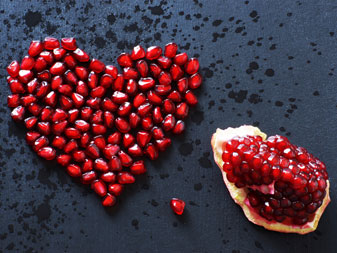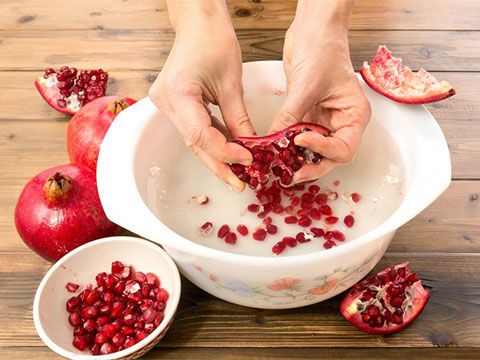The Power of Pomegranates
- By Miriam Wolf
- Last Updated On
- Reading Time: 3 mins.
 Of all the autumn fruits, the pomegranate is the most elegant and exotic. Leathery skin protects a tightly packed network of brilliant red juice-filled arils (the official name of the jewel-like seeds) cushioned by a bitter membrane. And whether those arils are floating in a flute of champagne or scattered across the top of a salad, they always lend a pop of color and a sense of drama.
Of all the autumn fruits, the pomegranate is the most elegant and exotic. Leathery skin protects a tightly packed network of brilliant red juice-filled arils (the official name of the jewel-like seeds) cushioned by a bitter membrane. And whether those arils are floating in a flute of champagne or scattered across the top of a salad, they always lend a pop of color and a sense of drama.
The pomegranate doesn’t give up its treasures without a fight—it takes a bit of work to eat one. But for people like my friend Rob, the work is worth it. “I love them. I love everything about them. And always plain. I need nothing else. Eaten one or two at a time, or 50 at a time. They are nature’s great exercise in patience and wonder.”
Rob—and all the other pomegranate superfans—have reason to rejoice this season: November is National Pomegranate Month. It’s a great time to celebrate the rich history and culture of this dramatic and delicious fruit.
Want fruit for your office?
Get your office a free sample TODAY!
The pomegranate is native to areas from the Middle East to the Himalayas. From there, it migrated to the Mediterranean, where it’s been grown for several millennia. It’s not surprising that fruit with such a deep history has picked up some symbolic baggage along the way: many cultures note the pomegranate’s profusion of arils and hold it up as an avatar of fertility or abundance. In the Jewish religion, it’s said that the 613 seeds inside mirror the 613 commandments in the Torah (in reality, pomegranates can have anywhere from around 200 to 1,400 arils). In Christian art, the baby Jesus is sometimes pictured holding a pomegranate; it symbolizes rebirth and the hope of immortality.
A bowl of pomegranates looks great as the centerpiece of any fall table—and if the symbolism holds true, they’ll invite abundance into your house.
If you want to hold on to the flavor of pomegranates past the month of November, here are a couple of ways to preserve their goodness.
Get tips for your office
Be an office hero!
 Pomegranate Molasses
Pomegranate Molasses
Adapted from The Splendid Table
INGREDIENTS
- 5–6 pomegranates
- 2 tablespoons water
- 1 tablespoon sugar
- Juice of 1 lemon
PREPARATION
- Fill a large bowl with water. Break open pomegranates in the bowl of water and separate arils from membrane and rind (membrane will float while the arils will sink). Drain arils and place in a blender. Pulse until the arils are broken and have released their juice. Strain through a mesh strainer, pressing on the solids to extract all of the juice.
- You should have about 4 cups of juice.
- Bring sugar and 2 tablespoons water to a boil. Lower heat to medium and cook, swirling the pan every so often until the syrup is a dark golden color—about 3 minutes. Remove from heat and let sit. The syrup will continue to darken. When it is the color of dark wood, carefully add a ¼ cup of the pomegranate juice—it will spatter, so stand back. Stir until the caramel has been incorporated into the juice. Then add the rest of the pomegranate juice and the lemon juice.
- Bring the mixture to a boil again and cook until the molasses has been reduced to about ⅔ cup. This should take about a half hour. The molasses will be thick and syrupy. Remove from heat and transfer to another container to cool. Molasses can be kept refrigerated for up to 1 month.
Prep time, 15–20 minutes; cook time, 40 minutes.
Pomegranate Chutney
Adapted from Manjula’s Kitchen
INGREDIENTS
- ½ pound tamarind, seeded
- 1½ cups boiling water
- 1 cup brown sugar
- 1 cup pomegranate arils
- 1 tablespoon cumin
- 1 tablespoon salt
- 1 teaspoon cayenne pepper (or less, to taste)
- ½ teaspoon ginger
- A few grinds of black pepper
PREPARATION
- Place tamarind in a bowl. Cover with boiling water and let sit for 15 minutes.
- Press the tamarind into a pulp. Strain through a mesh strainer, pressing on solids to extract as much pulp as possible. Add the sugar to the tamarind and mix well to dissolve.
- Add the rest of the ingredients. Mix well. Keep refrigerated for up to 2 weeks.
Want farm-fresh fruit?
We've got you covered.
Prep time, 20 minutes.
Miriam Wolf is the editor of The FruitGuys Magazine.
Recent Articles
Fresh From the Midwest: Lehman’s Orchard Grows Sweet Apples and More
Your Red Kiwi Guide: How It Compares to Its Colorful Cousins
Tasty Thanksgiving Recipes from The FruitGuys Team
The FruitGuys Ranks Among San Francisco’s Fastest-Growing Private Companies
Corporate Wellness Program Planning: Your 2026 Guide to a Healthier Workplace
Subscribe to our Newsletter
"*" indicates required fields



